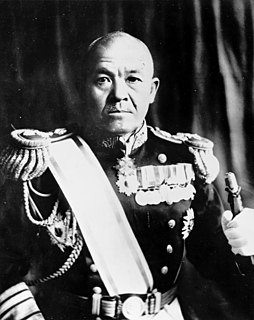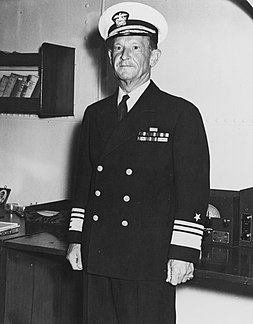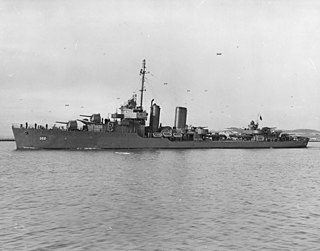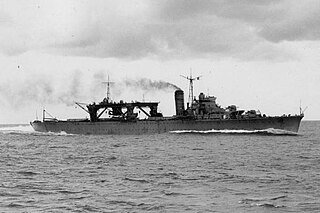| Royal Rodney Ingersoll II | |
|---|---|
 | |
| Born | 17 December 1913 Manila, The Philippines |
| Died | 6 June 1942 (aged 29) at sea, while serving in USS Hornet (CV - 8) in the vicinity of Midway Atoll |
| Allegiance | |
| Service/ | |
| Years of service | 1934 – 1942 |
| Rank | |
| Unit | USS Hornet (CV - 8) |
| Battles/wars | Battle of Midway |
Royal Rodney Ingersoll II (17 December 1913 – 6 June 1942) was an American junior naval officer, a graduate of the U.S. Naval Academy (1934), who was killed in battle early during the War in the Pacific.

The United States of America (USA), commonly known as the United States or America, is a country composed of 50 states, a federal district, five major self-governing territories, and various possessions. At 3.8 million square miles, the United States is the world's third or fourth largest country by total area and is slightly smaller than the entire continent of Europe's 3.9 million square miles. With a population of over 327 million people, the U.S. is the third most populous country. The capital is Washington, D.C., and the largest city by population is New York City. Forty-eight states and the capital's federal district are contiguous in North America between Canada and Mexico. The State of Alaska is in the northwest corner of North America, bordered by Canada to the east and across the Bering Strait from Russia to the west. The State of Hawaii is an archipelago in the mid-Pacific Ocean. The U.S. territories are scattered about the Pacific Ocean and the Caribbean Sea, stretching across nine official time zones. The extremely diverse geography, climate, and wildlife of the United States make it one of the world's 18 megadiverse countries.
Ingersoll was born in Manila, The Philippines, and he was the son of Admiral Royal E. Ingersoll, and the grandson of Rear Admiral Royal R. Ingersoll. After graduating from the United States Naval Academy in 1934, Ingersoll served on the battleship USS California (BB - 44), on the destroyer USS Cassin (DD-372), and other warships during 1934 - 41, and he reported on board the aircraft carrier USS Hornet (CV-8) during her fitting-out (pre-commissioning) period in 1941. Lieutenant Ingersoll served on the Hornet during the critical early months of the War in the Pacific, including on the famous Doolittle Raid on Tokyo in April 1942, the Hornet's maiden combat voyage.

Manila, officially the City of Manila, is the capital of the Philippines. It is the most densely populated city proper in the world. It was the first chartered city by virtue of the Philippine Commission Act 183 on July 31, 1901 and gained autonomy with the passage of Republic Act No. 409 or the "Revised Charter of the City of Manila" on June 18, 1949.
Admiral is a four-star commissioned naval flag officer rank in the United States Navy, the United States Coast Guard, and the United States Public Health Service Commissioned Corps, with the pay grade of O-10. Admiral ranks above vice admiral and below fleet admiral in the Navy; the Coast Guard and the Public Health Service do not have an established grade above admiral. Admiral is equivalent to the rank of general in the other uniformed services. The National Oceanic and Atmospheric Administration Commissioned Officer Corps has never had an officer hold the grade of admiral. However, 37 U.S.C. § 201 of the U.S. Code established the grade for the NOAA Corps, in case a position is created that merits the four-star grade.

Royal Eason Ingersoll was a United States Navy four-star admiral who served as Commander in Chief, U.S. Atlantic Fleet (CINCLANT) from January 1, 1942 to late 1944; Commander, Western Sea Frontier from late 1944 to 1946; and Deputy Commander in Chief, U.S. Fleet/Deputy Chief of Naval Operations (DCOMINCH/DCNO) from late 1944 to late 1945.
Ingersoll served on board the USS Hornet during the Battle of Midway from 4 June to 6 June 1942, in which the portion of the U.S. Navy fleet based in Hawaii decisively defeated the Imperial Japanese Navy (IJN) during its attack on Midway Island, sinking four IJN Japanese aircraft carriers.

The Battle of Midway was a decisive naval battle in the Pacific Theater of World War II that took place between 4 and 7 June 1942, only six months after Japan's attack on Pearl Harbor and one month after the Battle of the Coral Sea. The United States Navy under Admirals Chester Nimitz, Frank Jack Fletcher, and Raymond A. Spruance defeated an attacking fleet of the Imperial Japanese Navy under Admirals Isoroku Yamamoto, Chūichi Nagumo, and Nobutake Kondō near Midway Atoll, inflicting devastating damage on the Japanese fleet that proved irreparable. Military historian John Keegan called it "the most stunning and decisive blow in the history of naval warfare".

Hawaii is the 50th and most recent state to have joined the United States, having received statehood on August 21, 1959. Hawaii is the only U.S. state located in Oceania, the only U.S. state located outside North America, and the only one composed entirely of islands. It is the northernmost island group in Polynesia, occupying most of an archipelago in the central Pacific Ocean.

The Imperial Japanese Navy was the navy of the Empire of Japan from 1868 until 1945, when it was dissolved following Japan's defeat and surrender in World War II. The Japan Maritime Self-Defense Force (JMSDF) was formed after the dissolution of the IJN.
Lt. Ingersoll was killed at his battle station by machine gun fire from a crippled fighter plane (an F4F Wildcat) from the USS Yorktown (CV-5) during its emergency landing on board the Hornet. Its wounded pilot was either unable to, or failed to, cut off its guns.

A machine gun is a fully automatic mounted or portable firearm designed to fire rifle cartridges in rapid succession from an ammunition belt or magazine for the purpose of suppressive fire. Not all fully automatic firearms are machine guns. Submachine guns, rifles, assault rifles, battle rifles, shotguns, pistols or cannons may be capable of fully automatic fire, but are not designed for sustained fire. As a class of military rapid-fire guns, machine guns are fully automatic weapons designed to be used as support weapons and generally used when attached to a mount- or fired from the ground on a bipod or tripod. Many machine guns also use belt feeding and open bolt operation, features not normally found on rifles.

USS Yorktown (CV-5) was an aircraft carrier commissioned in the United States Navy from 1937 until she was sunk at the Battle of Midway in June 1942. She was named after the Battle of Yorktown in 1781 and the lead ship of the Yorktown class which was designed after lessons learned from operations with the large converted battlecruiser Lexington class and the smaller purpose-built USS Ranger. She was sunk by Japanese submarine I-68 on 6 June 1942 during the Battle of Midway.
Four enlisted men on board the Hornet were also killed, and 20 more sailors were wounded in this accident. [1]
In 1942, the destroyer USS Ingersoll (DD-652) was named in honor of both Rear Admiral Royal R. Ingersoll and Lt. Royal R. Ingersoll II. [2]

USS Ingersoll (DD-652) was a Fletcher class destroyer in the United States Navy, serving from 28 June 1942 through 19 May 1974. The Ingersoll was named for Admiral Royal Ingersoll, former Chief of Staff of the Atlantic Fleet in the early 20th century and his grandson Lieutenant Royal R. Ingersoll II who was killed in action during the Battle of Midway. Ingersoll saw action mainly in the Pacific Theatre of Operations during World War II, in support of the Korean War and in the Vietnam War.
Lt. Ingersoll's father, Admiral Royal E. Ingersoll, became the Commander-in-Chief of the U.S. Navy's Atlantic Fleet on December 30, 1941.
















